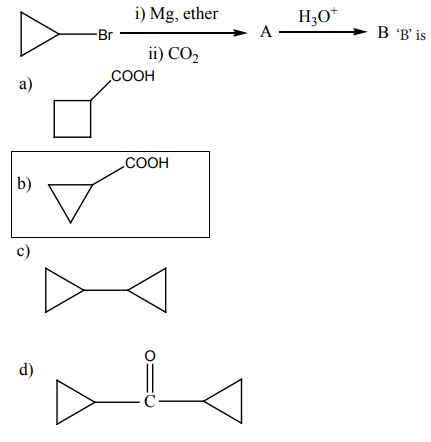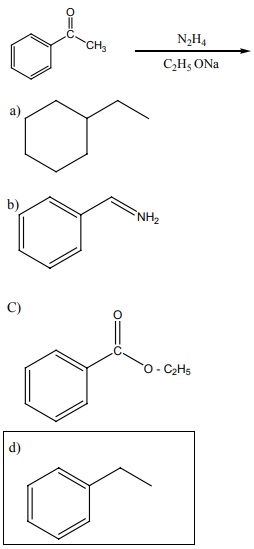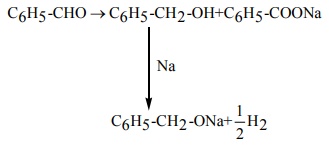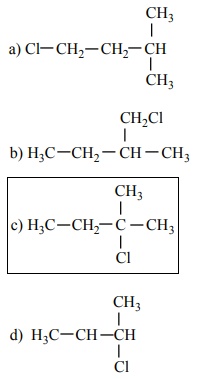Carbonyl Compounds and Carboxylic Acids | Chemistry - Choose the correct answer | 12th Chemistry : UNIT 12 : Carbonyl Compounds and Carboxylic Acids
Chapter: 12th Chemistry : UNIT 12 : Carbonyl Compounds and Carboxylic Acids
Choose the correct answer
Carbonyl Compounds and Carboxylic Acids | Chemistry
EVALUATION
Choose the correct answer:
1. The correct structure of the product ‘A’ formed in the reaction


Solution:

Option (b)
2. The formation of cyanohydrin from acetone is an example of
a) nucleophilic substitution
b) electrophilic substitution
c) electrophilic addition
d) Nucleophilic addition
Solution: Option (d)
3. Reaction of acetone with one of the following reagents involves nucleophilic addition followed by elimination of water. The reagent is
a) Grignard reagent
b) Sn / HCl
c) hydrazine in presence of slightly acidic solution
d) hydrocyanic acid
Solution: Option (c)
4. In the following reaction,  X Product ‘X’ will not give
X Product ‘X’ will not give
a) Tollen’s test
b) Victor meyer test
c) Iodoform test
d) Fehling solution test
Solution:

(x) reduces tollens reagent and Fehling solution and it also answers iodoform test.
Option (b)
5.  Y 'Y' is
Y 'Y' is
a) Formaldelyde
b) di acetone ammonia
c) hexamethylene tetraamine
d) oxime
Solution:
X-HCHO
Y-(CH2 )6N4
Option (c)
6. Predict the product Z in the following series of reactions
Ethanoic acid 
a) (CH3)2C(OH)C6 H5
b) CH3 CH(OH)C6H5
c) CH3CH(OH)CH2 - CH3
d) 
Solution:

Option (a)
7. Assertion: 2,2 – dimethyl propanoic acid does not give HVZ reaction.
Reason: 2 – 2, dimethyl propanoic acid does not have α - hydrogen atom
a) if both assertion and reason are true and reason is the correct explanation of assertion.
b) if both assertion and reason are true but reason is not the correct explanation of assertion.
c) assertion is true but reason is false
d) both assertion and reason are false.
Solution:

Solution: Option (a)
8. Which of the following represents the correct order of acidity in the given compounds
a) FCH2 COOH > CH3COOH > BrCH2 COOH > ClCH2COOH
b) FCH2 COOH > ClCH2COOH > BrCH2 COOH > CH3COOH
c) CH3 COOH > ClCH2COOH > FCH2 COOH > Br-CH2COOH
d) Cl CH2 COOH > CH3COOH > BrCH2COOH > ICH2COOH
Solution:
-I effect increases the acidity. If electronegativity is high, -I effect is also high.
Solution: Option (a)
9. Benzoic acid  C 'C' is
C 'C' is
a) anilinium chloride
b) O – nitro aniline
c) benzene diazonium chloride
d) m – nitro benzoic acid
Solution:

Solution: Option (c)
10. Ethanoic acid  – bromoethanoic acid. This reaction is called
– bromoethanoic acid. This reaction is called
a) Finkelstein reaction
b) Haloform reaction
c) Hell – Volhard – Zelinsky reaction
d) none of these
Solution: Option (c)
11. CH3Br  product (C) is
product (C) is
a) acetylchloride
b) chloro acetic acid
c) α- chlorocyano ethanoic acid
d) none of these
Solution:

Option (a)
12. Which one of the following reduces tollens reagent
a) formic acid
b) acetic acid
c) benzophenone
d) none of these
Solution:

Option (a)
13.

Solution:

Option (b)
14. The IUPAC name of 
a) but – 3- enoicacid
b) but – 1- ene-4-oicacid
c) but – 2- ene-1-oic acid
d) but -3-ene-1-oicacid
Solution:

Option (a)
15. Identify the product formed in the reaction

[Option: d]
Solution:
![]()
group is reduced to CH2 - (Wolff-kishner reduction)
Option (d)
16. In which case chiral carbon is not generated by reaction with HCN

Solution:

Option (a)
17. Assertion : p – N, N – dimethyl aminobenzaldehyde undergoes benzoin condensation
Reason : The aldehydic (-CHO) group is meta directing
a) if both assertion and reason are true and reason is the correct explanation of assertion.
b) if both assertion and reason are true but reason is not the correct explanation of assertion.
c) assertion is true but reason is false
d) both assertion and reason are false.
Solution:

Option (b)
18. Which one of the following reaction is an example of disproportionation reaction
a) Aldol condensation
b) cannizaro reaction
c) Benzoin condensation
d) none of these
Option (b)
19. Which one of the following undergoes reaction with 50% sodium hydroxide solution to give the corresponding alcohol and acid
a) Phenylmethanal
b) ethanal
c) ethanol
d) methanol
Solution:

Option (a)
20. The reagent used to distinguish between acetaldehyde and benzaldehyde is
a) Tollens reagent
b) Fehling’s solution
c) 2,4 – dinitrophenyl hydrazine
d) semicarbazide
Option (b)
21. Phenyl methanal is reacted with concentrated NaOH to give two products X and Y. X reacts with metallic sodium to liberate hydrogen X and Y are
a) sodiumbenzoate and phenol
b) Sodium benzoate and phenyl methanol
c) phenyl methanol and sodium benzoate
d) none of these
Solution:

Option (c)
22. In which of the following reactions new carbon – carbon bond is not formed?
a) Aldol condensation
b) Friedel craft reaction
c) Kolbe’s reaction
d) Wolf kishner reduction
Option (d)
23. An alkene “A” on reaction with O3 and Zn - H2O gives propanone and ethanol in equimolar ratio. Addition of HCl to alkene “A” gives “B” as the major product. The structure of product “B” is

Solution:

Option (c)
24. Carboxylic acids have higher boiling points than aldehydes, ketones and even alcohols of comparable molecular mass. It is due to their
a) more extensive association of carboxylic acid via van der Waals force of attraction
b) formation of carboxylate ion
c) formation of intramolecular H-bonding
d) formation of intermolecular H – bonding
Solution:
formation of intermolecular H-bonding
Option (d)
PTA Question
Oneword:
1. The general order of
reactivity of carbonyl compounds towards nucleophilic addition reaction is
a)
HCHO > RCHO > C6H5CHO > R2CO > (C6H5)2
b) HCHO > CH3CHO
> C6H5CHO > CH3COCH3 > C6H5COCH3
c)
C6H5COC6H5 > CH3COCH3
> C6H5CHO > CH5CHO > HCHO
d)
HCHO > CH3COCH3 > C6H5COC6H5
> CH3CHO > C6H5CHO
Answer:b)
2. Which one of the following
pairs is not correctly matched?
Reducing
agent - Name of the reaction
a)
Zn/Hg/Con.HCl - Clemension reduction
b) LiAlH4 -
Wolf-Kishner's reduction
c)
Pd/BaSO4 - Rosenmund's reduction
d)
SnCl2/Con.HCl - Stephen's reduction
Answer:b)
3. Which one of the following is
incorrectly matched?
a)
Tollen's Reagent – AgNO3 + NH4OH
b)
Fehlings solution - CuSO4 + Rochelle salt
c)
Benedict's solution - CuSO4 + Sodium citrate + NaOH
d)
Baeyer's Reagent - Con.HCl + anhydrous ZnCl2
Answer: d)
Related Topics